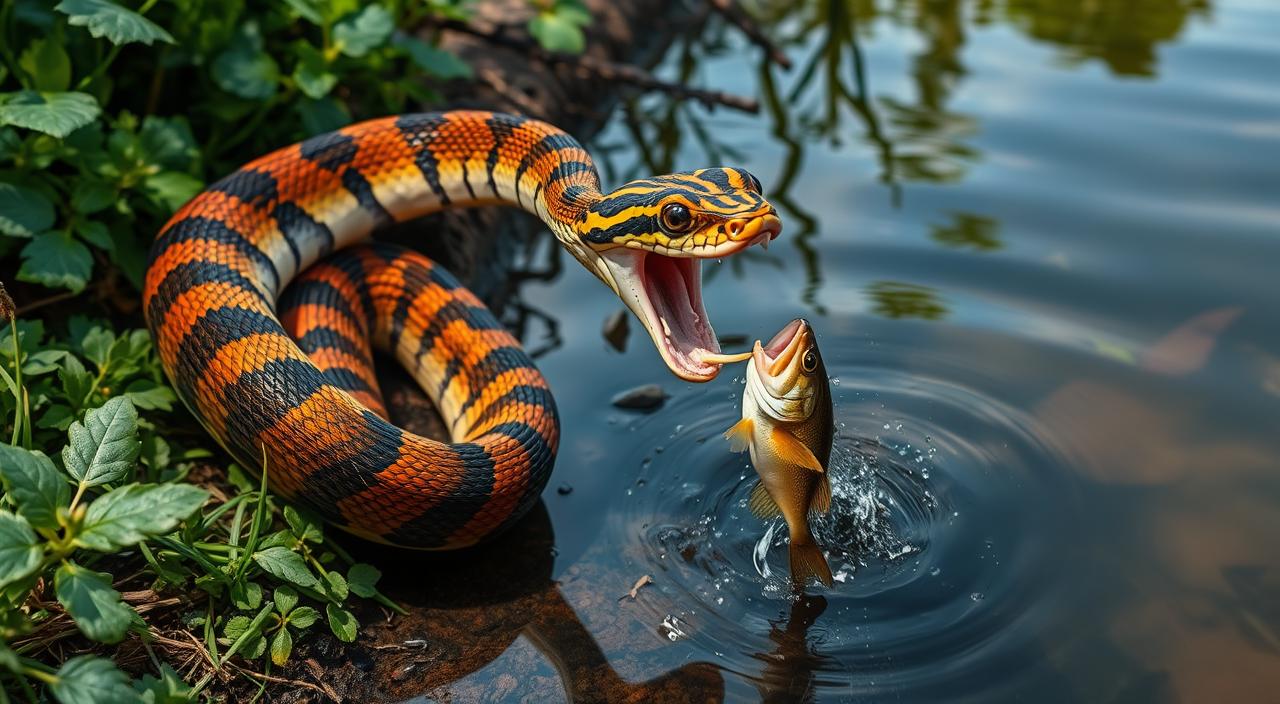Unveiling the Captivating World of the Tiger Snake
The tiger snake is a fascinating and deadly venomous snake in Australia. It plays a big role in the country’s diverse wildlife. Found in southern Australia, this snake is venomous and deserves respect and understanding.
As we explore the tiger snake’s world, we’ll learn about its importance. We’ll see how it impacts Australian ecosystems. Knowing how to identify a tiger snake is key.
Learning about the australian tiger snake is crucial. It shows the importance of conservation and living with these amazing creatures. Their striking looks and powerful venom remind us of nature’s beauty and power.
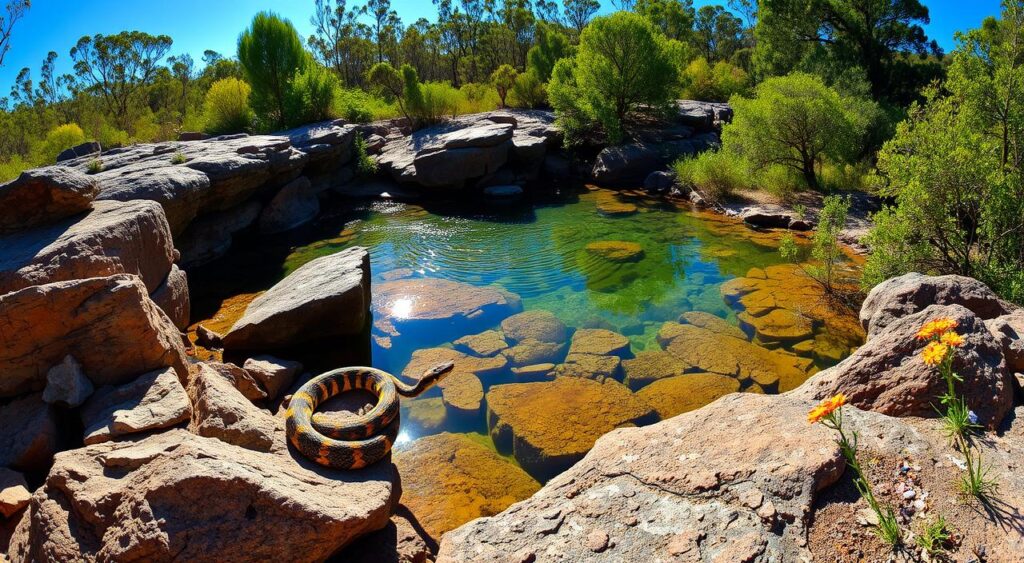
By diving into the tiger snake’s world, we appreciate these animals more. They play a big role in keeping Australian ecosystems balanced. Whether you love nature or just want to learn, the tiger snake will amaze and inspire you.
Key Takeaways
- The tiger snake is a venomous snake found in southern regions of Australia.
- Tiger snake identification is crucial for understanding and respecting these animals.
- Australian reptiles, like the tiger snake, play a vital role in maintaining ecosystem balance.
- Conservation efforts are necessary to protect the tiger snake and its habitats.
- Coexisting with tiger snakes requires awareness and understanding of their behavior and habitats.
- The australian tiger snake is an important part of Australia’s diverse wildlife.
Understanding the Tiger Snake: An Australian Icon
The tiger snake is a well-known elapid species in Australia, famous for its distinctive banding patterns. It’s a key part of wildlife of Australia, helping keep the ecosystem in balance. With many tiger snake species across the country, knowing their traits and habits is important.
Some interesting tiger snake facts include their ability to live in different places, like wetlands and forests. As australian animals, they’ve learned to thrive in Australia’s unique settings. Their venom is also noteworthy, used for hunting and defending themselves.
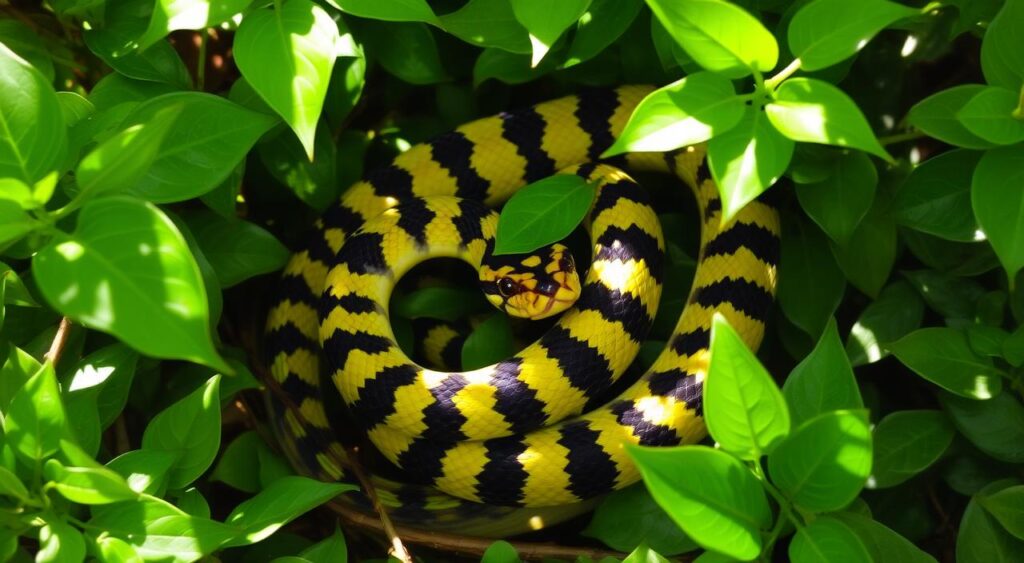
Let’s learn more about these amazing creatures. We’ll look at their physical traits, where they live, and their historical importance. By exploring tiger snake species, we can appreciate the need to protect wildlife of Australia.
Physical Characteristics and Markings
The tiger snake’s distinctive banding is easy to spot, with different patterns among tiger snake species. This unique look helps identify the species and understand their behavior.
Species Distribution in Australia
Tiger snakes are found in many parts of Australia, with different tiger snake species in different areas. Knowing where they live is key for conservation and showing the variety of australian animals.
Natural Habitat and Distribution Patterns
The tiger snake’s home is varied, from the coast to inland. They live in wetlands, grasslands, and forests. This makes them common in Australia. As an australian snake, they’ve learned to live in many places, from the coast to the heart of the continent.
Several things shape where they live:
- Climate: They do well in places with mild winters and warm summers.
- Food availability: They need small mammals, birds, and reptiles to eat.
- Shelter: They hide in rocks, logs, or burrows to avoid predators.
The habitat of tiger snake isn’t just on land. They’re great swimmers and live in swamps, rivers, and lakes too. This skill lets them live in many places, making them widespread in Australia.

In short, tiger snakes can live in many places. This lets them thrive in Australia, from the coast to the interior. They’re a key part of Australia’s snake life.
The Hunting and Feeding Behavior of Tiger Snakes
Tiger snakes are known for their aggressive behavior when hunting. This makes them a lethal snake to their prey. They eat small mammals, birds, and reptiles.
They live in many places, like wetlands, forests, and grasslands. Their aggressive serpent nature helps them survive in these environments. They ambush their prey.
Some of their favorite foods are:
- Small mammals, such as rodents and rabbits
- Birds, including nestlings and eggs
- Reptiles, such as lizards and other snakes
Tiger snakes are skilled hunters. They use their venom and agility to catch their prey. They hunt by ambushing, stalking, and chasing.
Their seasonal feeding patterns change. They mostly eat during the warmer months when there’s more prey.
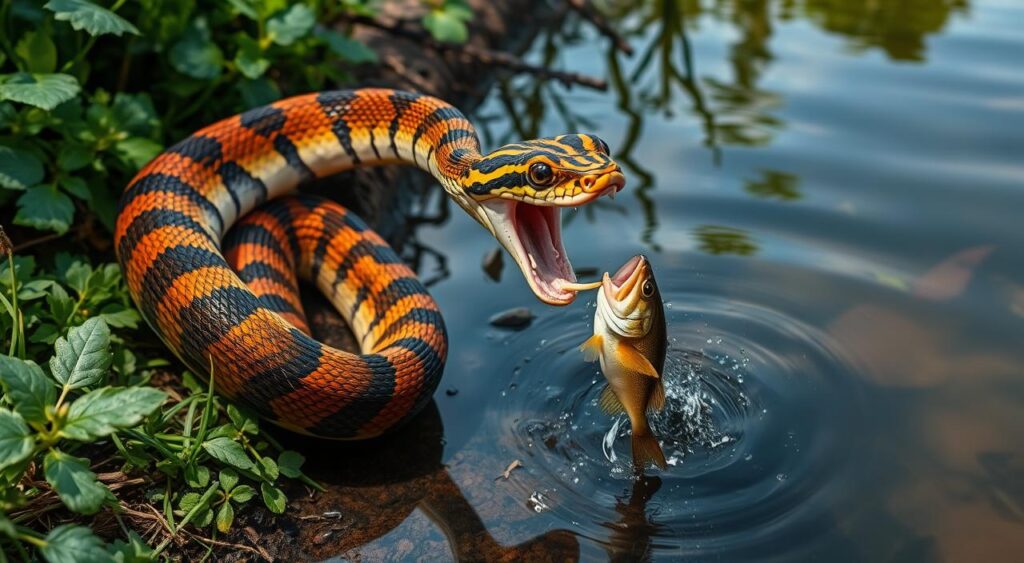
Understanding tiger snakes’ habitat and behavior is key. It helps us appreciate their role in the ecosystem. By knowing their aggressive behavior and lethal nature, we can live with them.
| Prey Species | Hunting Technique | Seasonal Feeding Pattern |
|---|---|---|
| Small mammals | Ambushing | Warmer months |
| Birds | Stalking | Year-round |
| Reptiles | Chasing | Cooler months |
Venom Composition and Medical Significance
The tiger snake venom is a complex mix of bioactive molecules. It makes the tiger snake one of the deadly and lethal snakes in Australia. A tiger snake’s deadly bite can cause severe pain, swelling, and breathing difficulties. This shows why quick medical attention is crucial.
The tiger snake is often at the top of the list of dangerous snakes. Its venom is a powerful neurotoxin. It can cause respiratory failure, renal failure, and cardiovascular collapse. But, thanks to medical technology and antivenom, survival chances have greatly improved.
It’s key to know the symptoms of a tiger snake bite. These include:
- Severe pain at the bite site
- Swelling and bruising
- Difficulty breathing
- Numbness or tingling
- Abdominal pain
As a deadly reptile, the tiger snake demands respect and caution. If someone is bitten by a tiger snake, staying calm and getting medical help right away is vital. With the right treatment, including antivenom, most people can get better from a tiger snake bite.

In conclusion, the tiger snake’s venom and its medical importance show why we should know about these lethal snakes. By understanding the risks and symptoms of a tiger snake bite, we can respect these dangerous snakes and their role in the Australian ecosystem.
Tiger Snake Behavior and Activity Patterns
Understanding tiger snake behavior is key to appreciating these reptiles. As dangerous reptiles, knowing their patterns helps us avoid them. Tiger snakes are active at different times of the year, with their actions changing with the seasons.
In summer, tiger snakes are more active. They look for food and mate. As deadly creatures, they are crucial to their ecosystem. They help keep their environment balanced. In winter, they are less active. They focus on finding shelter and saving energy.
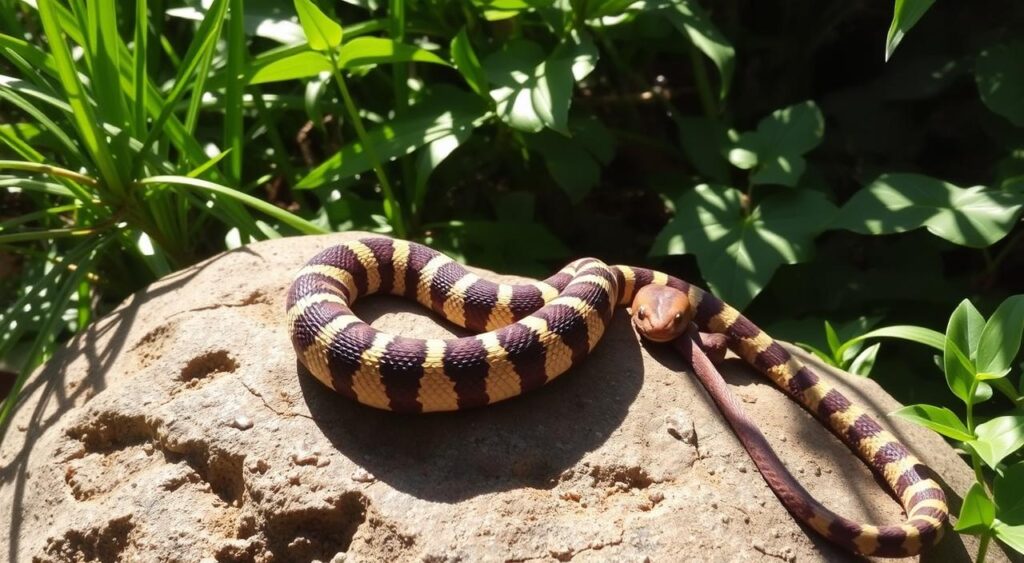
- Seasonal activities: They are more active during summer and less active during winter.
- Mating and reproduction: They mate during the spring, and the female lays her eggs in a sheltered spot.
- Territorial behavior: They are known to be territorial and will defend their territory from other tiger snakes.
By understanding tiger snake behavior, we can better appreciate these reptiles. We can also take steps to avoid them. It’s important to remember that tiger snakes are vital to their ecosystem. They play a key role in keeping their environment balanced.
| Season | Tiger Snake Behavior |
|---|---|
| Summer | Active, focused on finding prey and mating |
| Winter | Less active, focused on finding shelter and conserving energy |
| Spring | Mating and reproduction |
Safety and Snake Bite Prevention
When dealing with tiger snakes, safety is key. Their bites can be deadly. Knowing the signs of a snake bite is crucial for quick medical help. It’s important to learn how to handle snakes and take precautions around them.
In Australia, tiger snakes are common. Knowing how to spot them can help avoid bites. Look for their unique markings and aggressive behavior when threatened. This knowledge can lower the risk of a snake encounter.
If bitten by a tiger snake, get medical help right away. Treatment usually involves antivenom. Quick action can greatly improve the outcome. To help, stay calm, remove tight clothing, and keep the injured area low.
Recognition and Avoidance
- Avoid tall grass and bushy areas where tiger snakes are commonly found
- Wear protective clothing, including long pants and boots, when walking in areas where tiger snakes are present
- Be aware of your surroundings and watch for snakes in your path
First Aid Measures
In case of a tiger snake bite, stay calm and get medical help fast. Important first aid steps include:
- Removing any constricting items, such as watches or jewelry
- Keeping the affected limb below heart level
- Not attempting to suck out the venom or apply a tourniquet
Conservation Status and Threats
The tiger snake, a venomous reptile and deadly serpent, faces many threats. As an elapid snake, it’s vital for our ecosystem. But, human actions like destroying habitats, pollution, and climate change harm its survival.
Some major threats to tiger snakes include:
- Habitat loss and fragmentation from urbanization and farming
- Human-wildlife conflict, leading to snake killings
- Climate change, changing their food and home quality
We must tackle these problems with strong snake conservation plans. This includes protecting habitats, educating people, and doing research. Together, we can save the tiger snake and keep our ecosystem healthy. Tiger snake conservation is key to nature’s balance.
Supporting conservation and reducing our environmental impact can help. We must act now to protect the tiger snake and other venomous reptiles. It’s time to make a difference for these amazing creatures.
Living Alongside Tiger Snakes: Tips for Coexistence
Living with dangerous reptiles like tiger snakes requires respect for their snake habitat. In Australia, where they’re common, taking the right steps is key. Simple strategies can help reduce risks and create a peaceful space for both humans and wildlife.
Start by managing your garden well. Remove debris and rocks that attract reptiles. Keep your grass short. These steps can help keep tiger snakes away from your yard. Also, consider a fence to keep them out.
Garden Management
- Remove debris and rocks from your yard
- Keep your grass trimmed
- Install a fence around your property
When dealing with snake handling, it’s best to let experts handle it. If you see a tiger snake, stay back and call a wildlife expert. By following these tips, you can live safely with tiger snakes and enjoy watching them from afar.
Conclusion: Respecting Australia’s Remarkable Reptile
The tiger snake is a true icon of Australian wildlife, commanding both respect and fascination. These deadly snakes play a vital role in our ecosystems, helping to maintain a delicate balance in nature. While their venomous nature demands caution, we must also recognize the importance of tiger snake identification and responsible antivenom treatment in the event of a bite.
Through education and conservation efforts, we can learn to coexist peacefully with these dangerous snakes. We can appreciate their unique place in our environment. By understanding their behavior, habitat, and the measures to take for personal safety, Australians can develop a deeper respect for the tiger snake and its irreplaceable contribution to our diverse and captivating wildlife.
FAQ
What is a tiger snake?
The tiger snake is a venomous snake found in southern Australia. It has a unique banding pattern. It’s known as one of the deadliest snakes globally.
Where are tiger snakes found?
Tiger snakes live in coastal areas of southern Australia. This includes Victoria, Tasmania, and parts of South Australia. They like places with lots of water, like wetlands and riverbanks.
How can I identify a tiger snake?
Tiger snakes are sturdy and have a broad head. They have a distinctive banding pattern. Their eyes are small compared to their head.
What makes the tiger snake’s venom so deadly?
Tiger snake venom is very potent. It has neurotoxins, myotoxins, and coagulants. A bite can cause serious symptoms and even death if not treated quickly.
What should I do if I encounter a tiger snake?
Stay calm and slowly move away if you see a tiger snake. Don’t try to touch it or make sudden moves. If bitten, get medical help right away.
How can I help conserve tiger snake populations?
You can help by supporting conservation efforts. This includes protecting their habitats and funding research. Also, spreading the word about their importance helps their survival.
